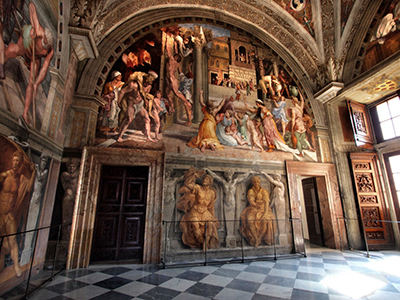The work of Raphael in the Sistine Chapel, along with fellow master Michelangelo, typified the High Renaissance in Rome
The contributions of both to this location was considerable, taking in several different art mediums. It is their frescos which are the most famous, with the four Raphael rooms displaying much of the best work. The Stanze di Raffaello, as they are known in Italian, are a sequence of reception rooms in the public areas of the Palace of the Vatican.
These four rooms are known individually as the Sala di Costantino (Hall of Constantine), the Stanza di Eliodoro (Room of Heliodorus), the Stanza della Segnatura (Room of the Signatura) and the Stanza dell'Incendio del Borgo (The Room of the Fire in the Borgo). Pope Julius II saw great artistic qualities in his child prodigy, Raphael, and tasked him with revamping these areas of the palace.
The ruling figures would frequently call upon the services of the Italian masters such as Da Vinci, Michelangelo and Raphael in order to ensure that their architecture and interiors were superior to competing local regions. Town hall buildings would become taller, grander and as a result, the three were never short of commissions.
The larger projects could not physically be completed by these artists alone and they would bring along trusted assistants from their studios. Gianfrancesco Penni, Giulio Romano and Raffaellino del Colle would complete the Sala di Costantino after their lead artist had passed away.
Raphael Cartoons
Raphael produced ten cartoon designs for future tapestries to be hung in the Vatican Palace. Only seven of the original cartoons remain, on display at the V&A in London. This series is perhaps the most respected contribution from Raphael's entire career and received acclaim from notable artists of that time, all the way up to the present day. Their existence in London helps to explain why this great master is so particularly loved within the UK.
Michelangelo disliked Raphael and would have seen this impressive series as a threat to his own success. The great masters were constantly competing against each other in order to receive the best commissions and leave the strongest legacy. Raphael was a gentler character than his rivals, preferring not to get involved with what he saw as petty squabbling. Projects such as helping to retain ancient architecture across Rome, for example, seemed far more significant to him.
Despite the complexity of these cartoons and the prominence of this project, Raphael was actually compensated relatively little for his work. As a relatively young artist, the significance of this commission on his reputation would have more then made up for any disappointment over his pay. To have his work sit against the recently completed Michelangelo ceiling would also have appealed to his ambitious side.




